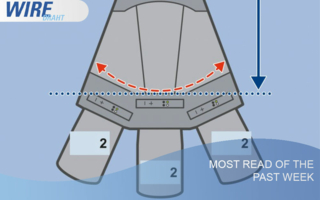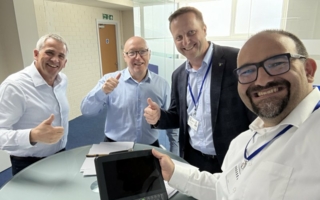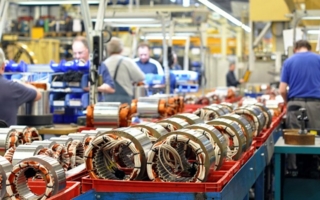28/03/2025 – HMI for safe machine operation in the automotive industry
Efficiency meets flexibility
Grob is a machine builder with core expertise in the automotive industry. In this success story, you can read how Grob, together with Keba, has succeeded in creating an HMI visualization for the safe operation of its machines and systems during maintenance, service and commissioning work.
Founded in 1926, the German Grob-Werke GmbH is a globally active, fourth-generation family-owned company based in Mindelheim, Bavaria. Grob is primarily active in the fields of universal machines, assembly systems, machining technology and electromobility, in particular with products for battery technology. Since its foundation, the company has expanded continuously and today, in addition to the main plant in Mindelheim, five other production sites have been established worldwide.
Industry trends
The automotive industry is currently characterized above all by the planned discontinuation of the combustion engine and the environmental technology targets to be achieved. Andreas Gindele, Team Leader Function Development HMI, explains: “Battery technology is naturally a major trend-setter, especially in the current discussion about gigafactories.”
Due to the naturally long lead times in the industry and the close coordination with its customers, Grob can adapt very well to trends and react flexibly to customer requirements. Flexibility and quick changeover are becoming increasingly important, especially in plant engineering. A lack of space and structural restrictions are always an issue and compact machine designs are all the more in demand. Martin Ellenrieder, Group Head of Functional Development at Grob: “We can adapt very well to trends and cover customer requirements with special machines. That is one of our company's specialties.” The so-called “hairpin” technology, a winding technology for stators in electric motors, has been one of the biggest trends in the automotive industry in the recent past.
Wanted: a new HMI device for commissioning, servicing and maintaining stations
The collaboration between Grob and Keba began in 2016, when a standard component was required for the commissioning of stations in the automated production of core components of electric drives. Triggered by the changeover to a Beckhoff controller, the search began for a suitable supplier for the required handheld operating device including visualization.
The requirement here is that the stations must be commissioned as efficiently as possible, i.e. in as little time as possible. The sometimes very large systems make a flexible concept for safe machine operation indispensable. The operator must be able to recognize possible movements at any time from his position and react accordingly. A location-independent connection to the machine is therefore a must. Another requirement was the integration of a web server-based machine visualization system.
Found: Mobile handheld operating devices from the “KeTop” series
The project started with the “KeTop T200” HMI device, which has since been replaced by the newer “T155” model. The basic requirement for using the HMI was that the commissioning engineer must be able to always ensure the safe operation of the machine in the system. Even if he moves away from the main control panel and enters the protected area of the system. It is also essential that the actuators can be safely stopped and stopped at any time during operation and that the machine parameters of the actuators and sensors required for servicing can be read out and edited.
Grob was impressed by the high-performance web visualization of the Keba handheld control unit and the open concept for individual configuration of the built-in interfaces. When the handheld control unit is connected to the respective connection box, it connects to the corresponding visualization from the web server. The unique addressing of the connection boxes also allows the displayed content to be individually adapted to the conditions on site. Several stations can be operated with just one hand-held control unit and the display provides a comprehensive and detailed presentation of all the necessary machine information. Andreas Gindele “Our main problem was the combination of different communication protocols between different software and hardware. There was a lot of development work involved here.”
Individual design through customizing options
The desire for a uniform, cross-station design concept was fulfilled thanks to the customizing options of the newer “KeTop T155”. For example, the softkeys on the keypad were adapted to Grob's specifications and the operating elements were given their own branding. There is praise for the appearance of the hand-held pendant stations: “The design of the hardware is very positive. It is elegant and appealing - they are durable devices,” says Gindele.
Future plans and open communication
Ellenrieder and Gindele are clear about what will happen in the coming years: “The future lies in e-mobility. This also includes battery assembly systems. Grob can offer automated system solutions here, from cell and module assembly to pack assembly.” They also see Keba and its handheld control unit solutions playing an important role in the future, also regarding the increasingly compact and complex designs of machines and systems.
As far as communication with Keba is concerned, both agree: “The cooperation with Keba has been open and we have been given concrete examples of how to implement the programming. It is also no problem to obtain a new HMI test device.”
Keba Industrial Automation GmbH
Reindlstrasse 51
4040 Linz
Austria
Contact person is Filip Miermans
Tel.: +43 732 7090-0
keba@keba.com
www.keba.com
About Keba Industrial Automation
Keba, founded in 1968, with headquarters in Linz (Austria) and subsidiaries worldwide, operates in three business areas: Industrial Automation, Handover Automation and Energy Automation. Controls and safety technology, drive technology for machines and robots, ATMs and parcel and transfer machines, as well as power charging stations for e-cars and heating controls, for example, are all part of the product portfolio of the automation expert, which employs around 2000 people. In te area of industrial automation, in line with the guiding principle "Automation by innovation", Keba develops and produces innovative and high-quality automation solutions for general mechanical engineering and machine tools as well as for Intralogistics, robotics, plastics, wind energy, turbo systems and sheet metal processing. Whether hardware or software, individual components or complete solutions - the Austrian technology expert offers powerful, modular and safe solutions for all industrial requirements. More information: https://www.keba.com/industrial-automation





